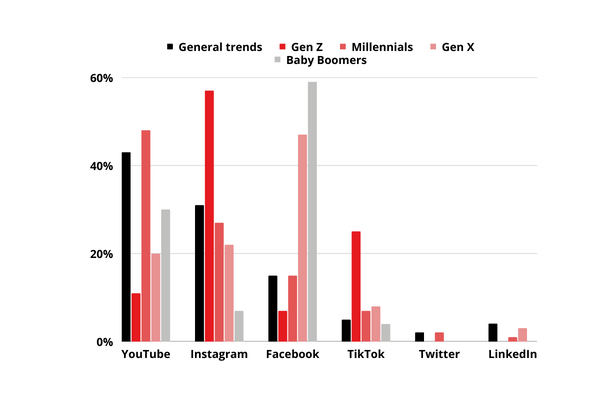The first documented online purchase was made in 1994. Just 25 years ago, and since then, we have come a long way, with online shopping evolving into a multi-trillion dollar predicted to hit $6.5 trillion by 2023 [1]. In 2020 Oberlo reported the presence of more than 2 billion online shoppers [2]. With no way to physically judge the purchase, consumers rely on public opinion, leading to a rise in user-generated content and the beginning of a new relationship with social media influencers.
In this article:
- The story of the origin & evolution of influencers
- The consumer influencer romance
- What drives a purchase decision?
- Trusted social media channels
- Conclusion
The story of the origin & evolution of influencers
Celebrities have been endorsing brands for a long time now. Initially, newspaper ads and billboard campaigns were the only way brands could promote their products. Later, social media became a more cost-effective and successful promotion method. Therefore, it would be incorrect to attribute the birth of influencers to the massive success of social media since the bottom line- getting paid to endorse the brand to entice the audience- remains the same. Still, social media is responsible for its evolution.
The rise of social media gave budding artists a platform to showcase their talent on a global level. Something that had never happened before the advent of social media. The only platform people had were the silver screen and TV, but social media provided a levelled playground for all that one could use to suit their needs. Every day, hundreds and thousands of new people join the online network. Gradually, like-minded people started boding and eventually developed a trust to build their tribes.
The generation of our parents put their trust in magazines and advice from family before making a purchase decision. Still, the internet gave people access to real people who had made the same purchase and had honest, unfiltered feedback about the product and the experience, which changed everything. Brands that were earlier behind the curtains were now on the frontline, and those who understood this nurtured lifetime relationships with their customers built on quality, experience and loyalty.
Also recommended: Top 10 Content Marketing Trends In 2022 To Stay On The Top
The consumer influencer romance
GenZ and millennials comprise the most tech-savvy generations that are as much on the internet as in the physical world. They are also one of the most well-read segments of society, and it is not easy to fool them amidst all the information available.

49% of consumers rely on what other consumers have said about the product on social media before making a purchase decision. The data shows that 57% of Gen Z consumers trust social media reviews and ratings, followed by 26% of millennials. Recommendations from influencers took the second spot, with 47% of consumers trusting influencer recommendations, with GenZers taking the lead with 53%. Opinions of friends & family, once the most trusted source of information, took a backseat bagging 39% of votes. Though the method is still prevalent amongst the millennials (48%), only 19% GenZers went to friends and family for opinions before making a purchase decision.
Better sure than sorry, the moto of baby boomers got reinforced with 61% saying they considered all of the above choices before finalising the purchase.
After being fed hundreds of fake commercials and false promises, Gen Zers and millennials have had enough! Infact, consumer demand has changed in the last few years, and all they seek is authenticity. They are no longer impressed by the highly-produced content. They seek refuge in fellow consumers and influencers, leading to a rise in the demand for UGC and a budding romance between the consumer and influencer.
Also recommended: Move Over Brand Deals! Content Creators & Influencers Are Now Using Knorish To Monetize Their Following With Digital Products
What drives a purchase decision?
Jazzy advertisements, celebrity endorsements and giant billboards no longer entice the new generation. What drives their purchase decision is trust. But what is trustworthy according to this generation?
Also read: How To Develop Customer Loyalty And Create Brand Loyalists
Our research revealed that 53% of the consumers abandoned a purchase because of a lack of user reviews (despite the presence of ratings), of which 43% were millennials, 37% were Gen Zers and 18 Gen Xers. The 47% who abandoned the purchase owing to a lack of both reviews and ratings were led by Gen X consumers (39%), followed by millennials (33%), Gen Z (27%) and 1% baby boomers.

The research findings clearly show that consumers are after authentic & honest user-generated content rather than flashy commercials. This is the content category they trust the most and are willing to bet on.
Trusted social media channels
Today, the best way for brands to reach their consumers is through social media. While social media simplifies mass outreach for the brands, it also empowers the consumers by providing them with a forum to vent out, but different generations have different picks. 48% of millennials trusted YouTube, 57% of Gen Zers trusted Instagram, and 47% of Gen Xers trusted Facebook for making a purchase decision.

Conclusion
Marketing and advertising have come a long way, and brands used different techniques to entice different generations. What worked for our parents will not work now. Therefore if brands wish to inculcate customer loyalty, they need to invest in UGC and influencer marketing, driven by trust and authenticity, on popular social media handles.
Download the complete report to know all the consumer trends emerging in 2022.
Endnotes
- https://www.statista.com/statistics/379046/worldwide-retail-e-commerce-sales/
- https://www.oberlo.com/statistics/how-many-people-shop-online
















